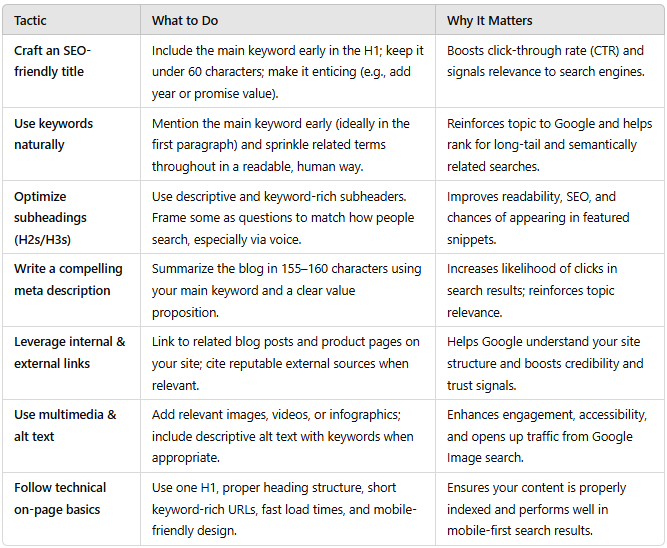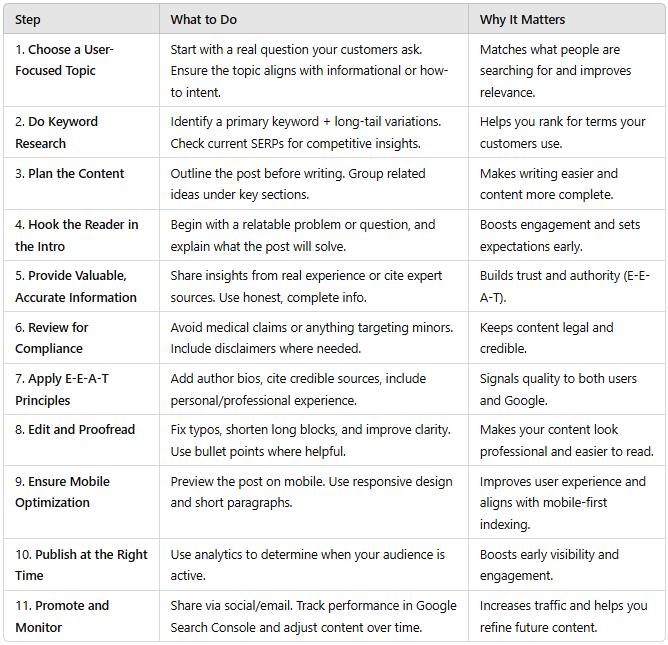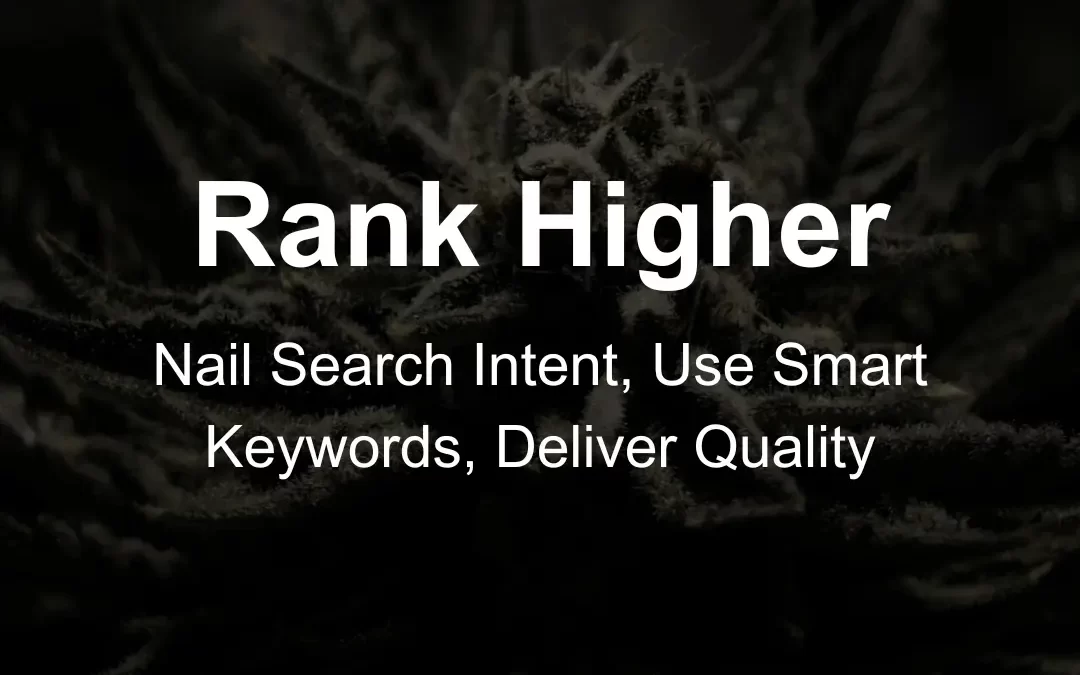Key Points
- Cannabis blog posts in 2025 requires focusing on AI-driven search trends, hyper-local optimization, and E-E-A-T (Experience, Expertise, Authoritativeness, Trustworthiness).
- Keyword research, high-quality content, and technical SEO are crucial for ranking, with an emphasis on local and long-tail keywords.
- Leveraging social media and Google Business Profile (GBP) for visibility, given advertising restrictions in the cannabis industry.
Cannabis retailers face a unique challenge in digital marketing: paid ads are often restricted, so organic search is your best friend.
That means producing blog content that ranks well on Google is crucial for attracting customers in 2025.
The good news is, a well-crafted cannabis blog can pull in massive traffic – for example, queries like “dispensary near me” receive over 2 million searches a month in the U.S.
But to capture this opportunity, you need to write posts that satisfy search intent, target the right keywords, and demonstrate high content quality.
Creating cannabis blog posts that rank well in 2025 involves understanding the unique challenges of the industry, such as regulatory compliance and competitive markets, while adapting to evolving SEO trends.
This guide will help you craft content that meets user search intent quickly, ensuring your posts are both engaging and optimized for search engines.
Understanding Search Intent In The Cannabis Industry
What Is “Search Intent”?
Search intent is the reason behind a query – what the user is really looking for.
Google’s algorithms heavily prioritize content that matches search intent.
For cannabis retailers, this means you must identify whether a target query is
- Informational (seeking knowledge)
- Transactional (seeking to buy something)
- Navigational (seeking a specific site/store)
- Commercial investigation (comparing options)
Tailoring your blog post to the correct intent is half the battle in ranking.
Cannabis consumers often have informational intent when searching blog content.
They might ask things like “How do CBD and THC differ?” or “Best cannabis strains for pain relief.”
These are questions seeking education and insights – perfect for a blog article.
In fact, as cannabis stigma fades, consumers increasingly want proper information; popular topics include explaining CBD vs. THC differences and how various strains affect health conditions.
On the other hand, a query like “cannabis dispensary near me” indicates local transactional intent – the user likely wants to find and visit a nearby store, not read a blog.
It’s important to recognize this so you don’t try to rank a blog post for a query better served by a store locator or Google Business listing.
How To Align With Search Intent
Before writing, put yourself in your customer’s shoes.
Ask: “What is this person hoping to learn or do from this search?”
If the intent is informational (e.g. “benefits of medical cannabis”), your post should purely educate and answer common questions on that topic – no hard selling.
If the intent is commercial (e.g. “best CBD oil 2025”), the user might expect recommendations or product comparisons, so a list-style blog or guide fits well.
By matching the format and depth of your content to what the searcher expects, you stand a far better chance of ranking.
Google rewards content that fulfills user needs comprehensively.
Keep in mind that in the highly regulated cannabis space, focusing on organic search intent is especially critical.
Advertising avenues are limited by laws and platform policies, so capturing organic traffic is a main growth driver.
One industry guide notes that cannabis stores operate in a highly regulated environment, making organic SEO crucial for visibility.
In practical terms, that means your blog content must work harder to answer customer questions and funnel readers toward your store, since you can’t lean as much on ads.
Nail the intent, and you’ll have readers finding exactly what they need on your site – and trusting your brand because you helped them.
Choosing Profitable Cannabis Blog Topics
Not all blog topics are created equal.
As a retailer, you want topics that drive traffic and appeal to potential customers.
Start by brainstorming the questions your customers ask most.
Do people come in asking about the difference between indica and sativa?
Are they curious about how to get a medical marijuana card in your state?
Such questions make excellent blog posts because they match real search queries.
Keyword Research For 2025
Use tools like Google Trends, Google Search Console, or SEO tools (Ahrefs, SEMrush, etc.) to see what cannabis-related queries are trending.
The cannabis industry evolves quickly, so keyword trends today might be different next year – it’s wise to update your keyword list frequently.
In fact, updating your cannabis SEO keywords every three to six months keeps your strategy aligned with changing search trends.
For example, searches for “cannabis delivery” surged during recent years and remain popular as more consumers look for convenience.
A content topic idea here could be “How Cannabis Delivery Works in [Your City] – 2025 Guide” if delivery is relevant to your business.
Look for high-volume and long-tail keywords relevant to your offerings.
High-volume examples (with nationwide monthly searches) might be broad terms like “cannabis dispensary”, “CBD gummies”, or “benefits of cannabis”.
These can have tens of thousands of searches (for instance, “CBD Gummies” gets around 165,000 searches/month in the US.
Broad topics are competitive, but if you can create an authoritative post, they’re hugely rewarding.
Meanwhile, long-tail keywords (more specific phrases) often indicate clear intent and less competition – think “best sativa strains for creativity” or “how to start a dispensary in New Jersey 2025”.
These may get fewer searches, but the traffic is highly targeted and easier to rank for.
Tip
Try a mix of evergreen topics and timely content. Evergreen posts (like “Health Benefits of Cannabis: What the Science Says”) will attract steady traffic over time.
Timely posts (like “New Cannabis Laws in 2025 – What Retailers Need to Know”) can capture search spikes around news or annual trends. Both are valuable in building your site’s overall authority.
Aim for topics that naturally relate to your products or location.
If you’re a dispensary in a tourist area, a blog about “Cannabis Travel Tips for Visitors to [City]” could pull in potential customers planning a trip.
To spark ideas, study what’s already ranking.
Search your target keywords and see the top results: what angle have they taken?
You don’t want to copy them, but you can identify gaps.
Perhaps every result for “edibles vs smoking” covers basics – you might differentiate by adding a section about onset time and dosage differences, giving extra value.
Also consider content that showcases your expertise or unique selling points.
For instance, if your dispensary is known for organic, pesticide-free products, a blog on “Why Organic Cannabis Matters (and How to Tell)” could draw interest and subtly promote your quality standards.
Lastly, verify that your chosen topics align with business goals.
“Funny cannabis memes of 2025” might get clicks, but does it bring in potential buyers?
Aim for topics that educate or inform readers who could become customers.
Educational content can improve your domain authority and engage readers, which in turn boosts SEO, but it should also tie back to your brand’s offerings or values.
Every blog post is an opportunity to guide a reader toward solving their problem – and if your product or store is part of that solution, even better.
Keeping a list of popular questions and keywords can help you plan cannabis blog content effectively.

Keyword Placement And On-Page SEO Best Practices
Once you have a great topic and target keyword, the next step is using that keyword (and related terms) strategically in your post.
Search engines still rely on keywords to understand content, so you want to send clear signals – without overdoing it.
Here’s how to use keywords for maximum SEO benefit.
- Craft an SEO-friendly title: Your title (H1) should include the primary keyword, preferably near the beginning, and be enticing to click. For example, a title like “10 Benefits of Medical Cannabis (Backed by Science) in 2025” has the keyword “benefits of medical cannabis” right up front, and promises updated info. Including a year or an intriguing angle can boost click-through rates. Keep the title around 60 characters if possible so it doesn’t get cut off in search results.
- Use keywords naturally in content: Aim to mention your main keyword in the first paragraph if you can do it naturally. This helps confirm to Google what the page is about. Then, throughout the post, sprinkle the keyword and close variants in a natural way. A good rule of thumb is to include the primary keyword every few hundred words, but focus on readability over a specific density. Google is very smart – it understands synonyms and context. In a cannabis blog about medical benefits, you might also use phrases like “therapeutic effects of cannabis”, “marijuana health benefits”, or “cannabis for pain relief” as variants. These related terms reinforce your topic and cast a wider net for long-tail searches. For example, using keywords like “cannabis dispensary,” “benefits of cannabis,” and “cannabis products” naturally throughout your content. The key word is naturally – your writing should sound human, not like a string of search terms.
- Optimize subheadings (H2s/H3s): Break your post into sections with descriptive subheaders, and try to work in keywords or synonyms there too. If your blog is “Guide to CBD for Pets”, you might have an H2 titled “How Does CBD Help Pets with Anxiety?” – this includes a related key phrase (“CBD help pets with anxiety”) that someone might search. Subheadings improve readability and give search engines more clues. They’re also helpful for voice search and featured snippets. Many users in 2025 search by asking questions (thanks to voice assistants), so consider phrasing some headers as questions that match those queries.
- Write a compelling meta description: While not a direct ranking factor, the meta description (the snippet of text under your link in Google) can impact whether people click your result. Keep it around 155–160 characters. Include your primary keyword and a clear, enticing summary of the post. For instance: “Learn how to write cannabis blog posts that rank in 2025. This guide covers search intent, profitable topics, keyword usage, SEO structure, legal compliance, and E-E-A-T for cannabis content.” This example packs in relevant terms (cannabis blog posts, rank in 2025, search intent, etc.) and tells the reader exactly what they’ll get.
- Leverage internal and external links: Link relevant words or phrases in your post to other pages. For example, when you mention cannabis strains, you might link to your previous blog post on “Top 5 Cannabis Strains for Relaxation,” or when discussing best practices, link to your product page for CBD oils. Internal links help distribute SEO authority around your site and keep readers engaged longer. They also signal to Google which pages are related. Similarly, linking out to authoritative external sources can boost your credibility (just don’t overdo it or link to competitors). If you cite a scientific study or a news article about cannabis laws, link to it – this shows you’ve done your research and can reinforce the trustworthiness of your content. It’s all part of good on-page SEO and user experience.
- Multimedia and alt text: Whenever you include images (which is encouraged – visuals make a post more engaging), be sure to fill out the alt text with a brief description that includes a keyword if relevant. For example, an alt tag like
alt="Cannabis edibles assortment"for a photo of edibles helps search engines understand the image. Google Image search is another traffic source, and alt text also assists accessibility for visually impaired readers. Additionally, consider adding other media if appropriate – short videos, infographics, or charts can increase time on page (a positive user signal) and help illustrate complex points. In 2025, video content is huge (some predict it’s the king of engagement), so even embedding a 1-minute explainer clip in your blog could set you apart. - Technical on-page must-dos: Ensure your blog page has a single H1 (the title) and use hierarchical heading order (H2 for main sections, H3 for sub-points, etc.). Use a clean URL structure – short and keyword-rich. For example,
.../blog/cannabis-blog-posts-ranking-2025is better than.../blog/post?id=123. Also, check your page’s load speed and mobile friendliness. Most cannabis searches happen on mobile devices, so a slow or non-mobile-optimized page will hurt your rankings. Compress images and use a modern, responsive site design. Google has moved to mobile-first indexing, meaning the mobile version of your site is what gets evaluated.
By covering these on-page SEO bases, you make it easy for Google to crawl and index your content – and you increase the likelihood of ranking for your target terms.
Remember that quality comes first: optimizing keywords helps the search engine see your relevance, but the content still needs to satisfy the reader (more on quality and E-E-A-T soon).
A final tip is to review Google’s own guidelines for content periodically.
In late 2022, Google released a “helpful content update” emphasizing people-first content – exactly what we’re aiming for.
If you adhere to these best practices, you’ll naturally be in line with Google’s recommendations.

Step-By-Step SEO Blog Post Checklist For Cannabis Retailers
Finally, here’s a handy checklist you can follow every time you write a cannabis blog post to ensure it’s primed for ranking.
- Choose a User-Focused Topic: Identify a question or topic your customers are asking. Make sure it aligns with search intent (informational, how-to, etc.) and has SEO value (people are searching for it).
- Do Keyword Research: Find a primary keyword for the topic (e.g., “cannabis benefits for anxiety”) and note related keywords and questions. Check current Google results for your keyword to understand what content you’re up against.
- Plan the Content: Outline the post with clear sections that cover all aspects of the topic. Decide on key points and supporting points. Ensure you have facts or examples for each.
- Hook the Reader in the Introduction: In the first few lines, address the reader’s problem or question and preview how the post will help them. If possible, work your main keyword in here naturally.
- Provide Valuable, Accurate Information: As you fill in each section, share what you know (experience), what research says (expertise), and practical tips. Back up claims with data or citations from credible sources when relevant. Be thorough and honest.
- Review for Compliance: Double-check that your content follows legal guidelines – no unsupported health claims, no encouraging illegal use, and appropriate audience targeting. Add disclaimers if needed. Ensure the tone is responsible and matches regulations (21+ etc.).
- Apply E-E-A-T Principles: Ask yourself, does the post show experience (maybe through personal insights or examples)? Does it convey expertise (accurate facts, thorough coverage)? Are you establishing authority (unique insights, maybe mention of credentials or years in business)? Is it trustworthy (well-written, unbiased, with sources cited and no clickbait)? Edit to improve these aspects if anything is lacking.
- Edit and Proofread: Read through the post to fix any grammar or spelling errors and to tighten up flow. A well-edited post appears more professional and trustworthy. Make sure paragraphs are short and skimmable. Where it makes sense, convert long sentences or lists into bullet points for clarity.
- Ensure Mobile-Friendly Formatting: Preview the post on a mobile screen. Large blocks of text or wide tables can be problematic – break text up and use responsive design elements. A good mobile experience can improve engagement and SEO.
- Publish (at the Right Time): Post your blog when your audience is most likely online, if possible. (Some retailers find late afternoons or weekends good for consumer content, but use your analytics insights.)
- Promote and Monitor: After publishing, share your blog on your social media channels, in email newsletters, or cannabis forums if appropriate. Promotion can earn you initial traffic (and maybe backlinks). Also, monitor how the post performs – check Google Search Console for what queries it’s ranking, and be ready to tweak the content or update it as needed to keep it ranking high.
By following this checklist, you’ll cover all the bases – from planning to publishing – for a high-ranking cannabis blog post.
Each step helps ensure that your content is useful for readers and optimized for search engines.
Final Thoughts
Writing cannabis blog posts that rank in 2025 is absolutely within reach for retailers who approach it strategically.
It comes down to understanding your audience’s intent, providing them with valuable information, and aligning that content with SEO best practices and compliance standards.
Prioritize helping the reader over “gaming” the search engine – ironically, that’s the surest way to win Google’s favor these days.
Every time you sit down to write, remember that your blog can be a powerful tool to educate, build trust, and ultimately turn searchers into customers.
Use the tips and steps above as a roadmap.
And if you ever feel overwhelmed by the process (keyword research, writing, optimization, etc.), don’t hesitate to seek assistance or invest in training – even a one-time consultation or using a professional content SEO service can set you on the right path.
Now, armed with this knowledge, it’s time to put fingers to keyboard and start creating content that will elevate your cannabis business in the search rankings.
Happy writing, and may your blog bloom on Google’s page one!

